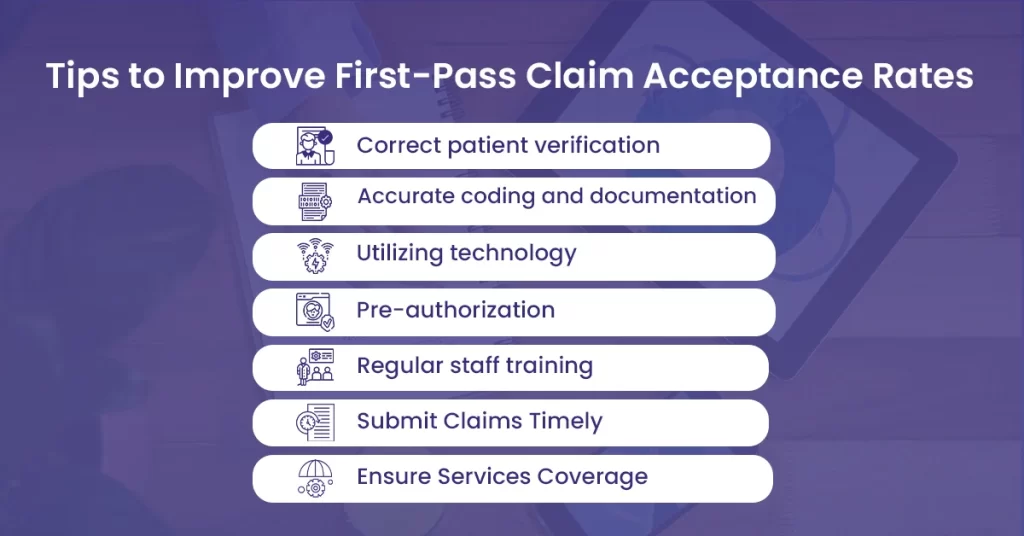In the intricate world of medical billing, the journey of a claim begins with its submission. Achieving a high first-time claim acceptance rate is crucial for optimizing revenue cycle management, reducing claim denials, and ensuring timely reimbursement. However, navigating the complexities of claim submission can be challenging, requiring healthcare organizations to implement strategic approaches to improve first-time claim acceptance rates. Let’s explore some effective strategies for enhancing claim acceptance rates and streamlining the billing process.
Ensure Accurate Patient Registration
The foundation of successful claim submission lies in accurate patient registration and demographic data collection. Implement robust patient registration processes to capture complete and correct patient information, including insurance details, contact information, and medical history. Verify patient eligibility and insurance coverage upfront to prevent claim rejections due to incomplete or inaccurate information.
Verify Insurance Coverage and Benefits
Perform thorough insurance verification and eligibility checks to confirm coverage and benefits for each patient encounter. Verify insurance eligibility, plan type, coverage limits, and deductible status to avoid claim denials related to coverage discrepancies or eligibility issues. Utilize electronic eligibility verification tools and real-time payer portals to streamline the verification process and ensure accurate billing information.
Optimize Documentation and Coding Practices
Ensure thorough documentation of medical services rendered, diagnoses, procedures, and treatment plans to support accurate coding and billing. Train healthcare providers and coding staff on proper documentation practices, coding guidelines, and compliance requirements to minimize coding errors and claim denials. Implement regular coding audits and quality assurance measures to identify and address documentation deficiencies proactively.
Submit Clean Claims Promptly
Submit clean claims promptly to payers, following billing guidelines, coding conventions, and payer-specific requirements. Double-check claim accuracy and completeness before submission to minimize errors and rework. Leverage electronic claim submission capabilities and clearinghouse services to streamline the claims submission process and reduce manual errors. Submit claims electronically whenever possible to expedite processing and improve claim acceptance rates.
Monitor and Analyze Claim Denials
Track and analyze claim denials to identify common trends, root causes, and patterns contributing to claim rejections. Implement robust denial management processes to investigate denied claims, appeal discrepancies, and resubmit corrected claims promptly. Utilize data analytics tools and reporting mechanisms to monitor claim acceptance rates, denial trends, and revenue cycle performance indicators, enabling proactive intervention and process improvement.
Foster Communication and Collaboration
Promote open communication and collaboration between billing staff, clinical teams, and administrative departments to streamline workflows and resolve billing-related issues effectively. Establish clear channels of communication for addressing claim inquiries, coding questions, and payer disputes promptly. Foster a culture of accountability and teamwork to ensure alignment of goals and priorities across the organization.
Stay Informed and Adapt to Changes
Stay abreast of changes in billing regulations, coding guidelines, and payer policies that may impact claim submission and acceptance rates. Invest in ongoing training and professional development for billing staff to ensure proficiency in evolving billing practices and industry standards. Adapt processes and workflows to accommodate changes in reimbursement rules, coding requirements, and technology advancements, optimizing claim acceptance rates and revenue cycle efficiency.
Conclusion
Improving first-time claim acceptance rates requires a proactive and multi-faceted approach that addresses patient registration, insurance verification, documentation practices, claims submission, denial management, communication, and continuous improvement. By implementing strategic strategies to enhance claim accuracy, completeness, and timeliness, healthcare organizations can optimize revenue cycle performance, reduce claim denials, and ensure timely reimbursement for services rendered. As the healthcare landscape continues to evolve, a commitment to excellence in claim submission and billing practices is essential for financial sustainability and success in the competitive healthcare marketplace.





